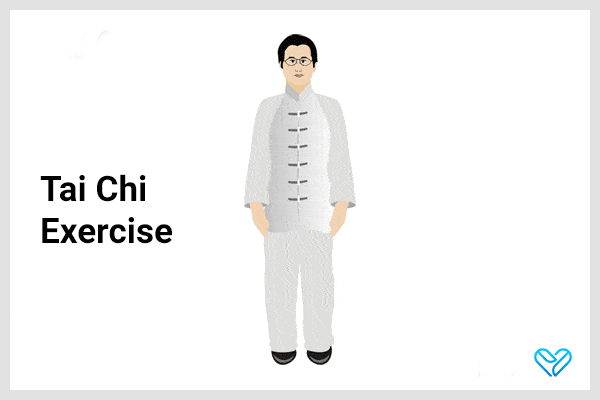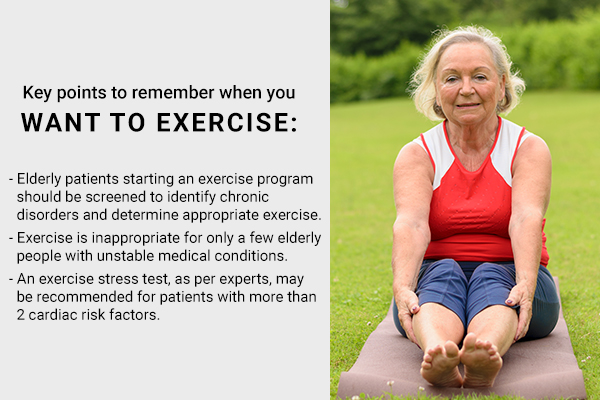In this article:
You must have heard before that physical activity is a must at every age. There have been speculations that long-term physical activity may prove to be beneficial in preventing the risk of health issues such as disability arising from reduced mobility.

As you age, your range of mobility decreases. It is a common indication of growing older.
Reduced mobility is a leading cause of various issues including:
- Morbidity
- Hospitalization
- Disability
- Mortality
According to a study focused on the benefits of long-term structured physical activity in the elderly, moderate-intensity physical activity reduces mobility disabilities by over 2.6 years among at-risk adults. This suggests the importance of exercising in senior adults. (1)
Take a look at some of the best exercises that the elderly can do to improve their quality of life.
Best Exercises for Senior Adults
Here are some beneficial and easy-to-do exercises for improving the health and wellbeing of senior adults.
1. Tai chi

Tai chi is often described as meditation in motion. It is a gentle form of exercise that helps maintain your strength, balance, and flexibility.
Tai chi originated in China as a form of martial art and has gained fame as a way of treating and preventing tons of health problems.
According to studies, tai chi can be associated with promoting mental and physical health by preventing health issues that arise as you age.
Tai chi consists of a series of motions that improve your lower limb strength and balance function. This enables fall prevention in the elderly.
Falls are a serious problem faced by older adults that can cause fatal complications. (2)(3)
2. Walking
The Chief Medical Editor of Harvard Health shared that walking is an essential way to stay healthy and mobile even in old age.
According to a report shared by the Lifestyle Interventions and Independence for Elders (LIFE) trial, older adults who didn’t exercise regularly were relatively frail. When asked to walk daily while also engaging in strength exercises, the volunteers observed an 18% drop in their risk of any episode of physical disability. (4)
Walking at least half an hour daily for 5 days a week is a good place to start your exercise regimen.
3. Cycle ergometer exercise
Cycle ergometers are stationary bikes that measure the amount of energy used during pedaling. Compared to walking and jogging, cycle ergometer training is easier and safer with the least risk of related injuries. It improves aerobic capacity and cardiovascular health.
Since it has a very low impact on the joints, it is not very stressful for the body in comparison to jogging or other running sports. This makes it feasible for even the frail elderly.
It has the potential to improve a person’s cardiorespiratory fitness, blood pressure values, and endurance parameters. It can also be linked to the prevention of metabolic and endocrine disorders. (5)(6)

4. Yoga
Lack of physical activity is linked with a decrease in balance proficiency, which is a risk factor for falling. Regular exercising leads to improvements in balance, thereby preventing falls and maintaining physical function in n the elderly.
One of the safe and effective forms of activity is yoga.
According to a research study, yoga intervention is linked to producing improvements in the measures related to the sense of well-being, energy, and fatigue in the elderly. (7)
5. Dancing
When you age, you experience a decline in mental and physical fitness.
According to a study published in Frontiers in Human Neuroscience, older people who regularly perform physical exercises can reverse the signs of aging in the brain. Dancing was said to have the most profound effect.
“Exercise has the beneficial effect of slowing down or even counteracting age-related decline in mental and physical capacity,” says Dr. Kathrin Rehfeld, lead author of the study, based at the German Center for Neurodegenerative Diseases.
Dancing is a good way for improving balance and brain structure in the elderly. (8)
6. Water aerobics
Based on research, aqua aerobic therapy is effective in improving the gait pattern and recovery time after a perturbation (sudden disturbance that causes a loss of balance or stability) in older adults.
The therapy resulted in significant reductions in body weight, body fat mass, and stride time, as well as significant increases in leg strength, which can help reduce the risk of falling.
Therefore, aqua aerobic or water aerobic therapy is an effective exercise method for older adults to improve health. (9)
7. Resistance band exercises
The effectiveness of resistance band exercises for improving physical and psychological dimensions among frail older adults has been inconsistent.
A review of 15 studies found that resistance band exercise reduced frailty and depression after 24 weeks, but had no significant effects on grip strength, leg strength, activities of daily living, or quality of life at any time.
Resistance band exercise might be considered a safe complementary intervention for frail older adults in the community or in long-term care facilities, but further research is needed to identify the effects of different training volumes and the dose-response relationship for the very old and frail population.
Health providers should consider recommending resistance band exercises as they have clinical benefits. (10)

8. Pilates
Research has found that Pilates can benefit elderly individuals (>60 years old) in areas such as dynamic balance, strength, mobility, functional capacity, risk of falling reduction, and mental and psychological health.
Pilates is affordable, safe for the majority of people, and has practical applications in the elderly population. (11)
9. Stretching
In one study, participants displayed improved step length and greater pelvic tilt and rotation after 12 sessions of stretching exercises.
The study suggested that stretching can be an effective way to improve the range of motion and reverse age-related changes that affect gait performance in older adults. (12)
Another study suggested that lower limb stretching exercises can be effective in improving balance and reducing falls in the elderly population. (13)
What Are the Benefits of Regular Exercise in the Elderly?
Regular exercise offers great benefits for seniors including: (14)
- Increased lifespan
- Better bone density
- Reduced risk of stroke
- Improved memory
- Prevention and treatment of various cardiovascular disorders, diabetes, osteoporosis, colon cancer, and psychiatric disorders, particularly mood disorders
- Preservation of skeletal muscle strength, aerobic capacity, and bone density, which contributes to mobility and independence
- Prevention of falls and fall-related injuries by enhancing muscle strength, balance, coordination, joint function, and endurance
- Increased opportunity for social interaction and an enhanced sense of well-being (14)(15)
Key Points to Remember When Exercising

- Elderly patients starting an exercise program should be screened to identify chronic disorders and determine the appropriate exercise for them.
- Exercise is inappropriate for only a few elderly people with unstable medical conditions. (15)
- Whether a complete pre-exercise medical examination is needed for those with chronic disorders depends on tests and clinical judgment.
- An exercise stress test may be recommended for patients with more than two cardiac risk factors.
- Doses of insulin and oral hypoglycemics may need to be adjusted in people with diabetes to prevent hypoglycemia during exercise. (16)
- Drugs that can cause orthostatic hypotension may need to be lowered to avoid exacerbation of orthostasis by fluid loss during exercise. Adequate fluid intake is essential during exercise for patients taking such drugs.
Additional Facts
Older adults should aim to engage in moderate-intensity aerobic activity for a minimum of 30 minutes on 5 days of the week or vigorous-intensity aerobic activity for at least 20 minutes on 3 days of the week, in order to promote and maintain good health.
Unfortunately, only a small percentage of older adults in the United States meet these recommendations, and a significant proportion (28 to 34%) of individuals aged 65 to 74 are inactive. This inactivity contributes to higher medical costs, which increase with age.
The elderly are less likely to exercise than other age groups due to various reasons, with the most common being physical limitations caused by health disorders. (17)
Most-Asked Questions
How much exercise is enough?
Start with 5 minutes of daily exercising and then slowly work up to 30 minutes per day.
Do I need to exercise even if I’m not overweight?
Regular exercising is important to maintain your healthy weight and reduce the health risks associated with obesity or a sedentary lifestyle.
I have several medical conditions. Is exercising safe for me?
If you suffer from a health condition, talk to your health professional about the precautions you need to take and what exercises you can perform safely without complications.
Which exercises are easy on the joints?

Here are some exercises you can do if you have joint problems: (18)
- Swimming
- Water walking
- Bicycling
- Walking
- Yoga
What exercises should be avoided by the elderly?
If you are aged 65 or older, it may be best to avoid the following exercises:
- Long-distance running
- Abdominal crunches
- Squats using dumbbells or weights
- Leg press
- High-intensity interval training
- Rock climbing
- Upright row
- Deadlifts
- Power clean
- Bench presses
Final Word
Getting older doesn’t have to mean that you can’t work out or exercise anymore.
It is a common practice to slow down and become lenient about physical activity with age. This can be due to the development of a sedentary lifestyle with age or simply because of health issues. Such an approach only worsens your health condition.
So, with increasing age, you should exercise regularly for the various health benefits associated with it.
- Was this article helpful?
- YES, THANKS!NOT REALLY


